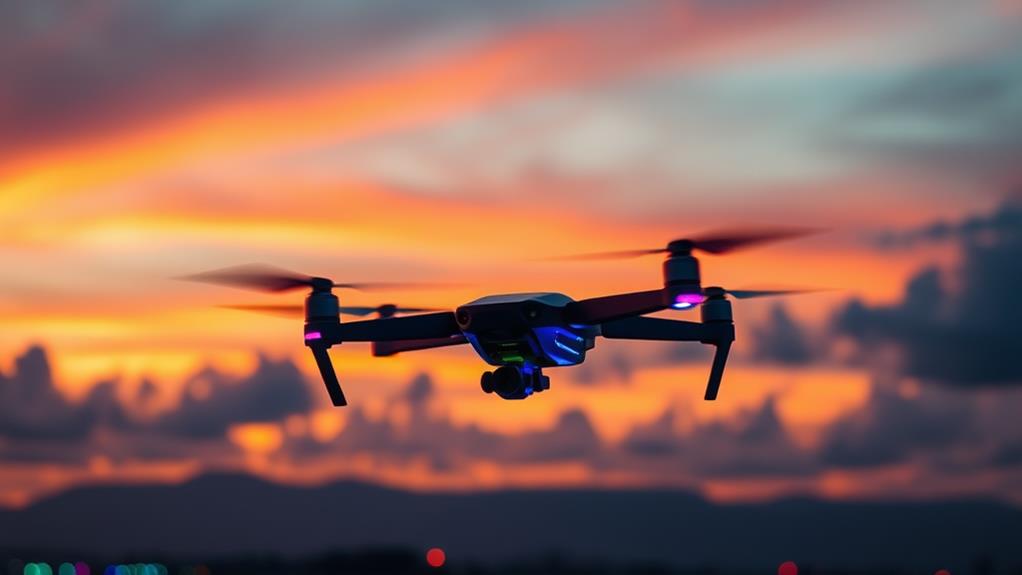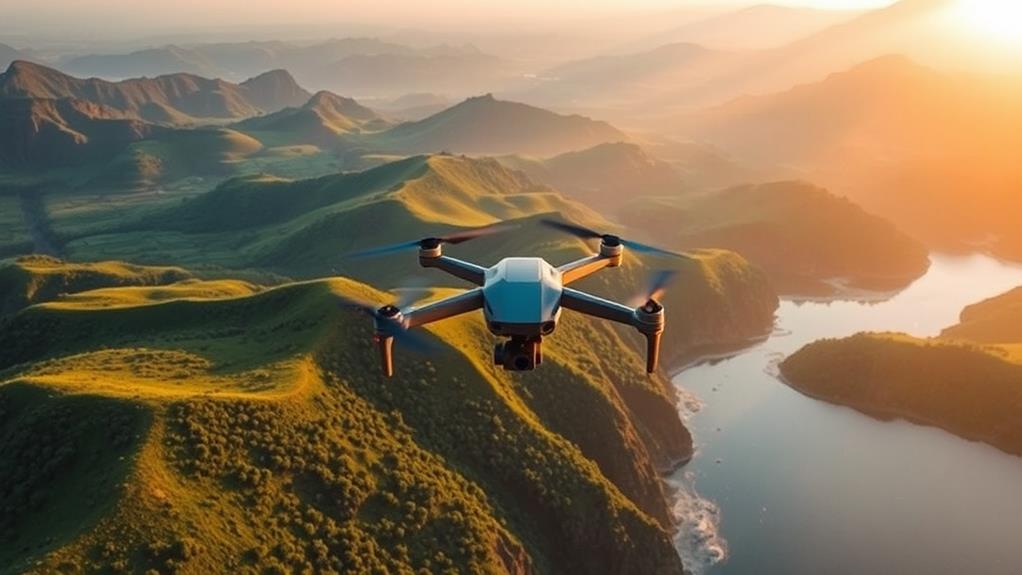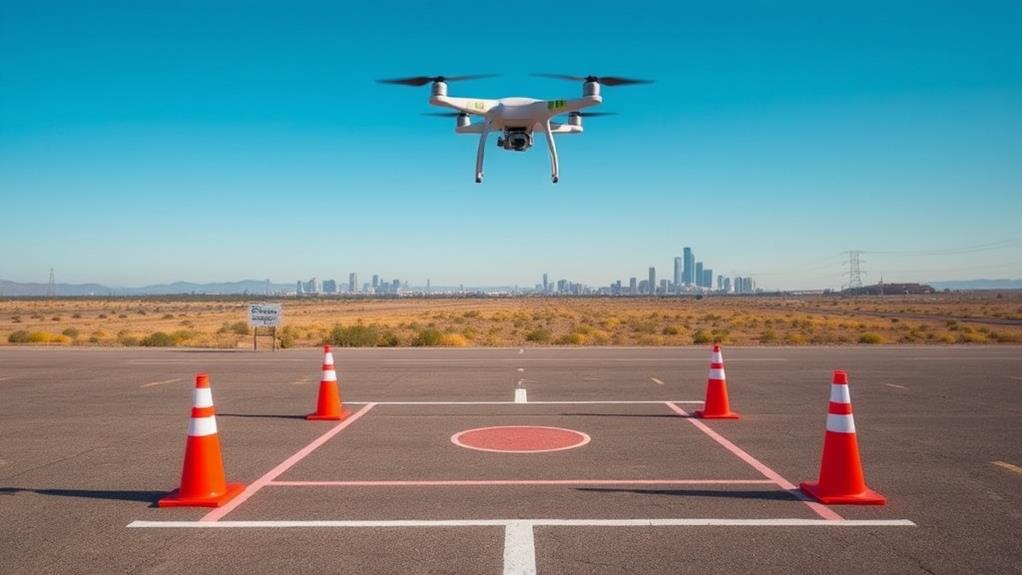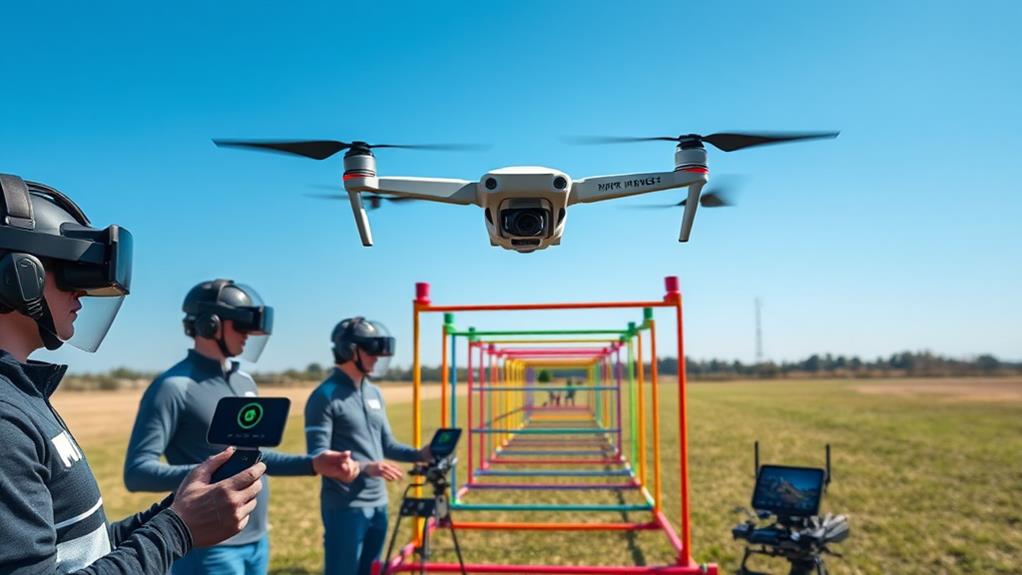To enhance your sport drone training, mastering advanced techniques is essential. Start with cinematic flying, which helps create dynamic shots to elevate storytelling. Incorporating waypoint navigation lets you pre-plan flight paths for capturing action smoothly. Focus on precision flying skills by practicing manual modes for better control. Additionally, developing strong spatial awareness improves your ability to navigate tricky environments and avoid obstacles. Train in challenging conditions to boost your confidence during unpredictable events. Finally, maintaining your drone is crucial for peak performance. Implement these strategies, and you'll discover even more ways to sharpen your skills and elevate your drone flying experience.
Advanced Flying Techniques

When training with sport drones, mastering advanced flying techniques is essential for achieving stunning aerial footage.
Utilizing Cinematic Flying Techniques like orbit shots and dolly zooms can greatly enhance your visual storytelling, allowing you to present athletes in dynamic ways. These techniques require strong piloting skills, enabling you to execute complex maneuvers with stability.
Incorporating Waypoint Navigation into your training can streamline the process of capturing sports action. By pre-planning flight paths, you can focus on the event while your advanced drone follows a designated route. This minimizes your workload and guarantees consistent coverage.
Spatial Awareness is another critical element; you'll need to navigate complex environments while avoiding obstacles, guaranteeing you capture important moments without interruption.
Additionally, training in challenging conditions—such as windy or rainy weather—will help build your confidence and adaptability. This experience is essential for operating effectively during real sports events, where unpredictable situations can arise.
Precision Flying Skills
To master precision flying skills, you need to get comfortable with manual flight modes like Sport and Acro, which let you perform intricate maneuvers at high speeds.
Fine-tuning your gimbal control is essential for capturing steady footage while you're executing these complex moves, so understanding the settings is key.
Additionally, developing your spatial awareness will help you navigate tricky environments and avoid obstacles, making your flying more effective and enjoyable.
Manual Flight Modes
Mastering manual flight modes, like Sport and Acro, is vital for any drone pilot looking to excel in capturing the fast-paced action of sports. These modes give you enhanced control and agility, allowing for precise maneuvers that are significant in dynamic sports environments.
By using manual flight modes, you can execute challenging techniques like power loops and barrel rolls, which help create engaging aerial footage.
Training in these modes develops your spatial awareness, enabling you to navigate around players and obstacles effectively during live events. This awareness isn't just about flying; it's about understanding your surroundings and adjusting your path to avoid collisions.
Additionally, honing your skills in manual flight modes promotes quick decision-making, allowing you to adapt to the rapid changes typical of sports scenarios, ensuring both safety and accuracy.
Advanced pilots often rely on manual flight modes to perform inverted flying and other intricate maneuvers, providing intriguing perspectives that enhance the storytelling of sporting events.
As you refine these skills, you'll find yourself better equipped to capture the essence of the game, making your footage stand out in a competitive landscape.
Fine-Tuned Gimbal Control
Achieving fine-tuned gimbal control is essential for capturing stable and smooth footage during fast-paced sports events. This skill allows you to make precise adjustments that compensate for any drone movements, ensuring your footage remains cinematic and engaging.
Mastering this technique combines manual piloting skills with an understanding of your gimbal's settings.
To enhance your gimbal control, consider these key practices:
- Understand Gimbal Settings: Familiarize yourself with tilt and pan rates to capture fluid motion shots.
- Advanced Gimbal Systems: Utilize systems with real-time stabilization to minimize vibrations and sudden movements.
- Coordinate Adjustments: Learn to synchronize gimbal adjustments with your flight maneuvers, keeping the camera focused on the subject.
- Practice in Various Flight Scenarios: Engage in training across different environments to build confidence and improve your skills in steering through complex aerial paths.
Spatial Awareness Development
Fine-tuned gimbal control lays the groundwork for capturing stunning aerial footage, but without strong spatial awareness, even the best gimbal work can falter in dynamic environments. Developing spatial awareness is vital for executing precision flying maneuvers effectively, especially when traversing challenging conditions.
To enhance your skills, practice in varied environments where you can learn to avoid obstacles and understand your drone's position relative to its surroundings.
Utilizing manual flight modes like Acro or Sport gives you finer control over the drone, improving your spatial awareness during dynamic maneuvers. One effective exercise is the Top Hat Maneuver, which helps you maintain orientation and control while maneuvering in three-dimensional space.
Regularly performing this exercise will boost your confidence in complex flight scenarios.
Incorporating real-time feedback and analysis of your flight sessions can greatly improve your spatial awareness. By identifying areas for growth, you can refine your precision flying skills and adapt to ever-changing environments.
Remember, strong spatial awareness enables you to navigate obstacles effectively, ensuring smoother and more skilled flying while capturing breathtaking footage.
Embrace these techniques, and watch your abilities soar.
Cinematic Video Techniques

When capturing cinematic footage with your drone, planning dynamic flight paths is essential for creating engaging visuals.
Using creative framing techniques can elevate your shots, allowing you to highlight athletes or plays effectively.
Dynamic Flight Path Planning
Precision in dynamic flight path planning transforms the way drones capture athletic performance. By employing waypoint navigation, you can pre-define a drone's route, allowing for smooth and precise execution of complex aerial maneuvers. This enhances the training experience for athletes and coaches alike.
Here are four key benefits of dynamic flight path planning in drone training:
- Enhanced Visual Storytelling: Cinematic video techniques, such as orbit and reveal shots, provide unique perspectives on athlete performance.
- Intricate Fly-Throughs: You can navigate tight spaces around athletes, capturing their techniques and movements in ways traditional filming cannot.
- Seamless Sliding Shots: This technique maintains a consistent distance from the athlete while following their movements, creating an engaging view of their training progress.
- Dramatic Dolly Zoom Effects: Altering the drone's distance while zooming in the opposite direction emphasizes key moments, adding excitement to sports footage.
Creative Framing Techniques
Creative framing techniques elevate sports drone training by offering unique perspectives that traditional filming often misses. You can enhance your aerial photography with advanced techniques like orbit shots, where the drone circles an athlete or team, capturing movement from multiple angles. This creates dynamic visuals that tell a richer story.
Another effective technique is the dolly zoom. By moving the drone away while zooming in, you emphasize the intensity of a play, making the action feel more dramatic.
Fly-throughs require advanced piloting skills, allowing you to navigate the drone through tight spaces, like goal posts, adding an engaging twist to the footage.
Reveal shots begin with a close-up of a player, then pull back to show the broader field context. This builds suspense and highlights strategic plays during training.
Drone Maintenance Essentials
Maintaining your drone is essential for ensuring peak performance during sports training sessions. Proper drone maintenance not only enhances reliability but also extends the life of your equipment.
To keep your drone in top shape, consider these key practices:
- Pre-flight Inspections: Always check for any visible damage, ensuring the propellers and landing gear are intact. This step can prevent mid-flight failures.
- Post-flight Inspections: After each session, inspect for wear and tear. Document any repairs needed, which helps track recurring issues.
- Battery Management: Implement correct charging and storage practices. Proper battery management can greatly prolong battery life and prevent unexpected power loss during training activities.
- Repairs: Familiarize yourself with basic repairs. Knowing how to replace propellers or landing gear allows you to address issues quickly, minimizing downtime.
Legal Compliance in Drone Use

When flying your drone for sports training, understanding legal compliance is key to both safety and success.
As a drone pilot, you'll need to familiarize yourself with the FAA regulations, especially the Part 107 drone regulations if you plan to use your drone commercially. This certification requires knowledge of airspace classifications, weather effects, and emergency procedures, ensuring you fly safely and responsibly.
Don't forget, drones weighing over 0.55 pounds must be registered with the FAA, with a small registration fee of $5 for three years. Staying updated on Temporary Flight Restrictions (TFRs) and Notices to Airmen (NOTAMs) is essential for maintaining safe flight operations in regulated airspace.
Local regulations also play a significant role in legal compliance. You should be aware of any privacy concerns or restrictions on drone usage in specific areas to avoid legal repercussions.
Enrolling in FAA-approved flight schools can provide you with the educational journey needed to become a compliant drone pilot. By prioritizing safety and adhering to these regulations, you can enhance your training experience and focus on improving your skills without the worry of potential fines or penalties.
Educational Resources for Pilots
As you commence your journey to become a skilled drone pilot, tapping into the right educational resources can make all the difference. With the right tools, you can enhance your knowledge and skills effectively. Here are some essential resources for aspiring aviators today:
- AV8 Prep Online Ground School: This program offers flexible curricula, providing access to experienced instructors who cover aviation regulations and safety in depth.
- Interactive Modules: These engaging components cater to various learning styles, allowing you to create personalized study plans that enhance retention.
- Free E-book: Download "The Ultimate Guide – How to Become a Pilot" for valuable insights and resources to kickstart your aviation journey.
- Simulation Software: Utilize this tool for practical skill development opportunities, enabling you to practice advanced maneuvers in a risk-free environment before applying your skills in real-world situations.
Additionally, joining a community of aspiring aviators fosters collaboration and continuous learning, where you can network and share experiences.
An education program has got to be thorough, covering risk assessment and safety, which are essential for capturing the complexities of drone piloting.
Conclusion
Incorporating advanced techniques into your drone training can take your skills to new heights. By honing your precision flying, mastering cinematic techniques, and understanding maintenance and legal aspects, you're setting yourself up for success. Remember, it's not just about flying; it's about flying smart. With the right resources, you can navigate the skies like a pro. So, gear up and take the plunge—your journey into the world of drone flying is just beginning!

Leave a Reply